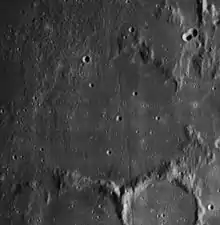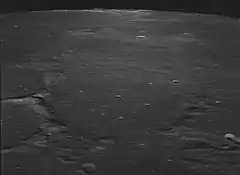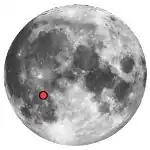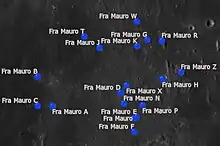Fra Mauro (crater)
Fra Mauro is the worn remnant of a walled lunar plain. It is part of the surrounding Fra Mauro formation, being located to the northeast of Mare Cognitum and southeast of Mare Insularum. Attached to the southern rim are the co-joined craters Bonpland and Parry, which intrude into the formation forming inward-bulging walls. The crater is named after Italian geographer Fra Mauro.[1]
 Lunar Orbiter 4 image Apollo 14 landing site is near center of top margin of image | |
| Coordinates | 6.0°S 17.0°W |
|---|---|
| Diameter | 95 km |
| Depth | None |
| Colongitude | 17° at sunrise |
| Eponym | Fra Mauro |

Description

The surviving rim of Fra Mauro is heavily worn, with incisions from past impacts and openings in the north and east walls. The rim is the most prominent in the southeast, where it shares a wall with Parry. The remainder consists of little more than low, irregular ridges. The maximum elevation of the outer rim is 0.7 km.

The floor of this formation has been covered by basaltic lava. This surface is almost divided by clefts running from the north and south rims. There is no central peak, although the tiny crater Fra Mauro E lies at almost the midpoint of the formation.
Apollo missions
The area north of Fra Mauro crater was the intended landing site of the ill-fated Apollo 13 mission, which was aborted after an oxygen tank aboard the spacecraft exploded. The crew later returned safely to Earth. The next mission, Apollo 14, landed at Fra Mauro. The Apollo 14 crew (Alan Shepard and Edgar Mitchell) sampled breccia that had been deposited here by the Imbrium basin-forming impact, and which partly covers Fra Mauro. This rough debris blanket of ejecta is referred to as the "Fra Mauro Formation".
Satellite craters
By convention these features are identified on lunar maps by placing the letter on the side of the crater midpoint that is closest to Fra Mauro.

| Fra Mauro | Latitude | Longitude | Diameter |
|---|---|---|---|
| A | 5.4° S | 20.9° W | 9 km |
| B | 4.0° S | 21.7° W | 7 km |
| C | 5.4° S | 21.6° W | 7 km |
| D | 4.8° S | 17.6° W | 5 km |
| E | 6.0° S | 16.8° W | 4 km |
| F | 6.7° S | 16.9° W | 3 km |
| G | 2.2° S | 16.3° W | 6 km |
| H | 4.1° S | 15.5° W | 6 km |
| J | 2.6° S | 18.6° W | 3 km |
| K | 2.5° S | 16.7° W | 6 km |
| N | 5.3° S | 17.4° W | 3 km |
| P | 5.4° S | 16.5° W | 3 km |
| R | 2.2° S | 15.6° W | 3 km |
| T | 2.1° S | 19.3° W | 3 km |
| W | 1.3° S | 16.8° W | 4 km |
| X | 4.5° S | 17.3° W | 20 km |
| Y | 4.1° S | 16.7° W | 4 km |
| Z | 3.8° S | 14.6° W | 5 km |
 Fra Mauro B from Lunar Orbiter 1
Fra Mauro B from Lunar Orbiter 1 Fra Mauro R, from Apollo 14
Fra Mauro R, from Apollo 14 Oblique view of Fra Mauro T, from Lunar Orbiter 3
Oblique view of Fra Mauro T, from Lunar Orbiter 3
References
- "Fra Mauro". Gazeteer of Planetary Nomenclature. International Astronomical Union. Retrieved 19 August 2017.
- Andersson, L. E.; Whitaker, E. A. (1982). NASA Catalogue of Lunar Nomenclature. NASA RP-1097.
- Bussey, B.; Spudis, P. (2004). The Clementine Atlas of the Moon. New York: Cambridge University Press. ISBN 978-0-521-81528-4.
- Cocks, Elijah E.; Cocks, Josiah C. (1995). Who's Who on the Moon: A Biographical Dictionary of Lunar Nomenclature. Tudor Publishers. ISBN 978-0-936389-27-1.
- McDowell, Jonathan (July 15, 2007). "Lunar Nomenclature". Jonathan's Space Report. Retrieved 2007-10-24.
- Menzel, D. H.; Minnaert, M.; Levin, B.; Dollfus, A.; Bell, B. (1971). "Report on Lunar Nomenclature by the Working Group of Commission 17 of the IAU". Space Science Reviews. 12 (2): 136–186. Bibcode:1971SSRv...12..136M. doi:10.1007/BF00171763. S2CID 122125855.
- Moore, Patrick (2001). On the Moon. Sterling Publishing Co. ISBN 978-0-304-35469-6.
- Price, Fred W. (1988). The Moon Observer's Handbook. Cambridge University Press. ISBN 978-0-521-33500-3.
- Rükl, Antonín (1990). Atlas of the Moon. Kalmbach Books. ISBN 978-0-913135-17-4.
- Webb, Rev. T. W. (1962). Celestial Objects for Common Telescopes (6th revised ed.). Dover. ISBN 978-0-486-20917-3.
- Whitaker, Ewen A. (1999). Mapping and Naming the Moon. Cambridge University Press. ISBN 978-0-521-62248-6.
- Wlasuk, Peter T. (2000). Observing the Moon. Springer. ISBN 978-1-85233-193-1.
External links
Related articles
- Wood, Chuck (May 7, 2005). "Buried and Textured". Lunar Photo of the Day. Archived from the original on January 7, 2016. Retrieved September 23, 2017.
- Wood, Chuck (March 29, 2007). "How High the Moon: Or at Least a Few Peaks". Lunar Photo of the Day. Archived from the original on June 14, 2011.
- Wood, Chuck (June 22, 2007). "Residual Ridges". Lunar Photo of the Day. Archived from the original on June 14, 2011.
- Wood, Chuck (August 1, 2014). "Pitted Pyramid". Lunar Photo of the Day.
